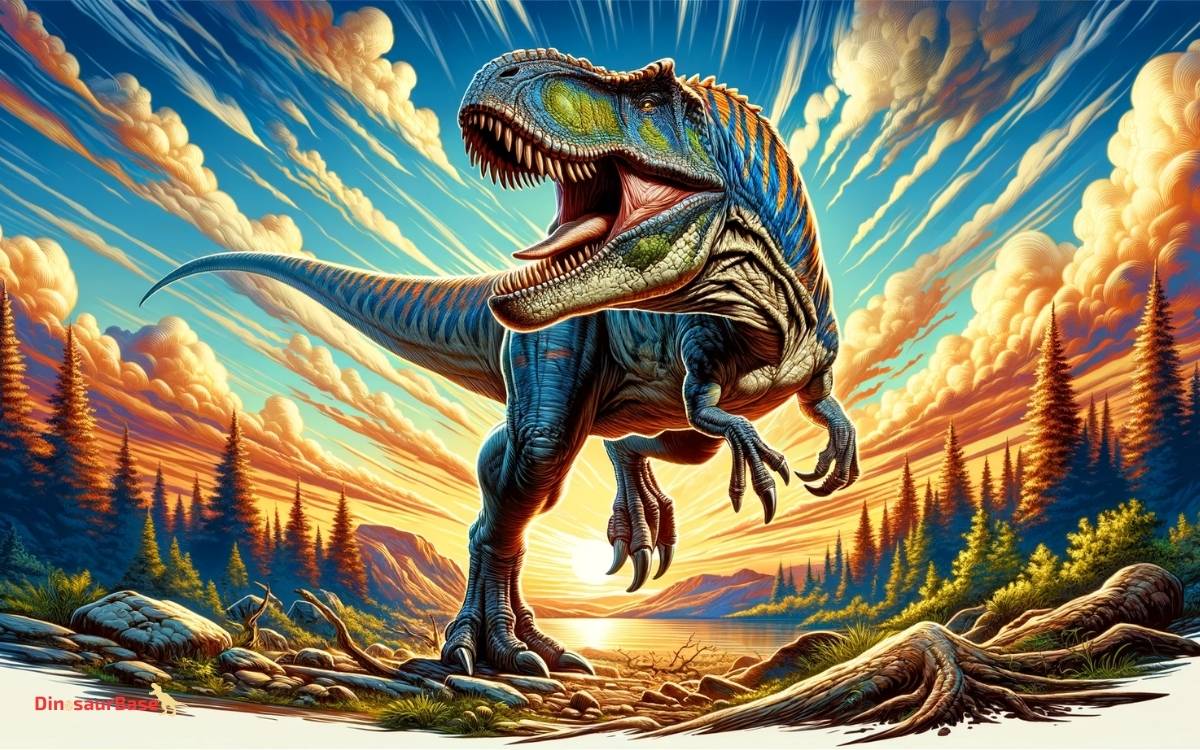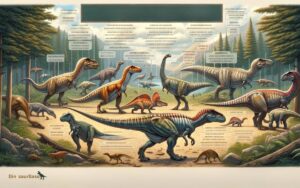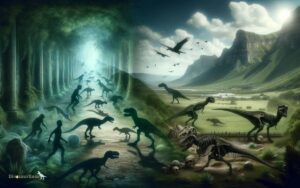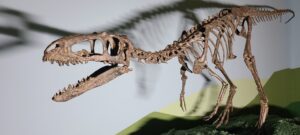How to Identify an Allosaurus Dinosaur: A Beginner’S Guide
To identify an Allosaurus, look for a large skull, short arms, and three-fingered hands. This Jurassic predator also has distinct crests above its eyes.
Embarking on the journey of dinosaur identification can bring about an exhilarating sense of discovery, especially concerning the formidable Allosaurus.
Known as one of the most ferocious dinosaurs of the Late Jurassic period, the Allosaurus stands as a focal point of interest for paleontology enthusiasts.
Understanding the Allosaurus not only enriches our knowledge of prehistoric life but also helps to contextualize the evolution of predatory dinosaurs.
With its characteristic physical traits and a reputation that looms as large as its fossilized bones, this dinosaur captures the imagination and drives curiosity.
The guide that follows aims to simplify the identification process, making it accessible to beginners eager to explore the ancient world where these incredible creatures roamed.

The Allosaurus Unveiled
The Allosaurus stands as a towering figure from the past. This prehistoric predator has captivated the minds of paleontologists and enthusiasts alike.
Unveiling the mystery behind this ancient beast, we embark on a journey to understand what sets the Allosaurus apart.
Jurassic Era Juggernaut
Roaming the land during the late Jurassic period, the Allosaurus was a formidable carnivore. Its reign spanned approximately 155 to 145 million years ago. Known for its large skull and powerful jaws, the Allosaurus was a dominant force.
- Stood up to 12 meters long
- Weighed over 2 tons
- Featured dozens of sharp teeth
- Had strong, muscular legs
Paleontological Significance
The Allosaurus is not just an icon of prehistoric life; it plays a key role in our understanding of the Jurassic ecosystem.
Its fossils provide insights into predator-prey dynamics and the adaptation strategies of carnivorous dinosaurs.
| Attribute | Significance |
|---|---|
| Fossil Abundance | Indicates Allosaurus’ success as a species |
| Variety in Size | Suggests a complex growth cycle and social behavior |
| Growth Rings in Bones | Helps estimate lifespan and growth rates |
| Injury Patterns | Gives clues about hunting techniques and lifestyle |
Physical Attributes Of The Allosaurus
Unearthing the mysteries of prehistoric life often begins with understanding the beasts themselves.
Let’s delve into the physical attributes of the Allosaurus, a fearsome predator that roamed the Earth during the late Jurassic period.
For any beginner, recognizing these features is a step closer to visualizing this incredible creature that once dominated ancient landscapes.
Distinctive Skull Features
The Allosaurus had a large skull with sharp, serrated teeth that it used for hunting. Its head boasted a pair of horn-like crests above its eyes, giving it a distinctive look.
Notable for the large openings in the skull, known as fenestrae, these features made the skull lighter and provided space for muscle attachment.
- Massive jaws capable of powerful bites
- Horn-like crests for a fierce appearance
- Large fenestrae for a lighter skull structure
Limbs And Locomotion
Designed for predation, the Allosaurus had strong hind legs that suggested it was a capable runner. Its three-fingered arms were muscular and could grasp prey, albeit shorter in comparison to its body size.
- Two strong hind legs for agile movements
- Short but powerful forelimbs with sharp claws
The Allosaurus likely used its tail for balance, enabling swift turns while pursuing prey.
Size And Stature Comparisons
| Feature | Measurement | Comparison |
|---|---|---|
| Length | Up to 12 meters | Longer than a school bus |
| Height | Up to 5 meters | Taller than a giraffe |
| Weight | 2,000 – 3,000 kilograms | As heavy as an SUV |
This table shows how the Allosaurus compares in size and stature to objects we’re familiar with today. It stood poised on two legs, towering above many of its contemporaries.
Fossil Record Footprints
The Fossil Record Footprints give us a sneak peek into the lives of dinosaurs, including the Allosaurus. It’s like following the footsteps of these ancient giants to unveil their secrets.
Understanding these rocky remnants helps us piece together the puzzle of how the Allosaurus lived, hunted, and roamed the earth.
Global Dig Sites
Scientists have been like detectives, seeking clues across our planet. They have found Allosaurus fossils in North America, particularly in the United States’ rocky Morrison Formation.
Europe and Africa have also contributed pieces to this prehistoric puzzle, with discoveries in Portugal and Tanzania.
Key sites include:
- Cleveland-Lloyd Dinosaur Quarry: This site in Utah is like a treasure chest for Allosaurus bones.
- Lourinhã Formation: Portugal’s fossil-rich area that has revealed Allosaurus fragments.
- Tendaguru Beds: Tanzania’s contribution with bones stretching our knowledge further.
From Bones To Reconstructions
After unearthing the bones, experts turn these rocky fragments into full-scale, lifelike models. First, they study the fossils, measure them, and understand how they fit together.
With careful artistry, they then craft the Allosaurus. These models show us the fierce predator it once was, towering up to 12 meters long.
List of steps from bones to models:
- Uncover fossils with precise tools.
- Analyze each piece and categorize them.
- Model the skeleton digitally or using casts.
- Build the full-scale reconstruction.
- Finalize details like skin texture and color.
| Bone discovery | Description process | Display preparation |
|---|---|---|
| Unearth fossils | Analyze and categorize | Build reconstruction |
| Measure bones | Model digitally | Finalize model details |
The Allosaurus In The Ecosystem
The Allosaurus roamed the Jurassic period, over 150 million years ago. This giant lizard shaped its environment. Its role in the ecosystem was crucial. It impacted plant life, prey species, and other predators.
Dietary Habits
Understanding an Allosaurus’ dietary habits is like looking into a prehistoric food web. Allosaurus was a meat eater, known in science as a carnivore. Its diet consisted of:
- Large herbivores: Creatures like Stegosaurus and Apatosaurus were main courses.
- Smaller dinosaurs: Juveniles and smaller species added variety.
- Possibly fish and carrion: For easier snacks without the hunt.
Predator Or Scavenger Debate
Was the Allosaurus a fierce predator or a clever scavenger? This question sparks debate in paleontology. Key findings that fuel this discussion include:
| Predator Clues | Scavenger Clues |
|---|---|
| Sharp teeth marks on bones | Healed bite wounds on prey fossils |
| Powerful jaws for bone-crushing | Evidence of eaten remains long after death |
| Forelimbs with strong gripping claws | Comparison with modern scavengers’ behavior |
Today’s scientists study fossils and modern predators to guess Allosaurus’ habits. Some evidence points to a stealthy hunter. Others suggest a patient scavenger, waiting for a meal. The debate continues.
Differentiating Allosaurus From Other Dinosaurs
Stepping back in time, enthusiasts encounter a mesmerizing world of prehistoric creatures. Among them, the Allosaurus stands out.
Understanding how to distinguish this dinosaur from its ancient relatives is both exciting and enlightening. Sharpen your paleontology skills as we explore the unique features setting Allosaurus apart.
Tyrannosaurus Rex Vs. Allosaurus
Allosaurus and Tyrannosaurus Rex often get mixed up. While both are apex predators, subtle nuances hint at their differences. Let’s delve into the physical and historical traits that separate these two titans of the Mesozoic Era.
- Time Period: T. Rex roamed later than Allosaurus.
- Size and Build: T. Rex was bulkier with a heavier skull.
- Arms: Allosaurus had longer, more functional arms.
- Teeth: T. Rex teeth were robust, while Allosaurus had sharper, serrated ones.
Key Differentiators For Identification
Recognizing an Allosaurus is easy once you know what to look for. Focus on these features to confirm your discovery:
| Feature | Allosaurus |
|---|---|
| Head Crests | Prominent bony ridges above its eyes. |
| Jaw Flexibility | A unique hinge-like joint in the skull. |
| Claws | Three-fingered hands with sharp claws. |
| Body Proportions | Slender and agile with a long tail for balance. |
Modern Representations And Cultural Impact
Step back in time and imagine the roar of an Allosaurus echoing through the Jurassic landscape. This mighty predator does not only captivate paleontologists but also holds a special place in our modern culture.
Allosaurus In Museums
Seeing an Allosaurus up close is an awe-inspiring experience. Museums around the world display this dinosaur’s fossilized bones and recreations.
- Natural History Museums: They offer a chance to see Allosaurus skeletons and understand their size and power.
- Interactive Exhibits: Some museums feature displays where you can learn about Allosaurus through activities and multimedia.
These experiences bring the ancient world to life for people of all ages.
The Dinosaur In Popular Media
Allosaurus has become a beloved character in books, movies, and television. Let’s explore two key ways this dinosaur has impacted popular culture.
| Jurassic Media | Children’s Books and Toys |
|---|---|
| Appears in films and video games. Featured in documentaries that educate and entertain. | Stars in stories that spark curiosity in young readers. Transforms into toys and models for creative play. |
The Allosaurus captures hearts and ignites imaginations, reminding us of the wonders of our prehistoric past.
Frequently Asked Questions On How To Identify An Allosaurus Dinosaur: A Beginner’s Guide
How Do You Identify An Allosaurus?
An Allosaurus can be identified by its large skull, sharp teeth, long tail, and three-fingered hands. Its distinctive features include horn-like crests in front of the eyes.
What Are The Characteristics Of The Allosaurus?
The Allosaurus was a large theropod with sharp teeth and formidable claws. It roamed the Jurassic period, averaging 28 feet in length. This predator featured a large skull with powerful jaws, and its body structure suggests it was agile. Allosauruses likely hunted in packs.
What Is An Allosaurus Dinosaur For Kids?
An Allosaurus is a large meat-eating dinosaur that lived millions of years ago during the Jurassic period. It walked on two legs and had sharp teeth and claws.
What Does An Allosaurus Look Like?
An Allosaurus was a large, bipedal dinosaur with sharp teeth, clawed hands, and a muscular build. Its head featured a pair of short, bony crests above its eyes.
Conclusion
Embarking on your paleontological journey just got easier. Identifying an Allosaurus encompasses recognizing unique skeletal structures, understanding its habitat, and studying its behavior.
With the essential pointers outlined, beginners can confidently distinguish this incredible dinosaur. Keep exploring, and let your curiosity guide you through the prehistoric realms.





